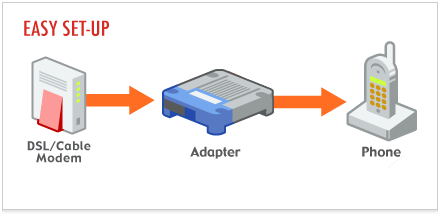HOW DOES VOIP WORKS ?
VoIP works just like a regular phone with just one key difference — how the phone call actually gets to your telephone. Instead of using the high priced telephone company's wiring, VoIP routes your phone calls directly to your telephone using your high speed internet connection. You hear a dial tone and make your phone calls just like you've always done. What's changed is that you don't pay a big bill to use the phone company's wires. |
 |
Cost savings. The most attractive feature of VoIP is its cost-saving potential. When we move away from public switched telephone networks, long-distance phone calls become inexpensive. Instead of being processed across conventional commercial telecommunications line configurations, voice traffic travels on the Internet or over private data network lines.
Rich media service. The legacy phone system mainly provides voice and fax service even though limited video service is possible. However, the demand of users is much higher than that, as shown in today's rich media communications through the Internet. People check out friends' presence (such as online, offline, busy), send instant messages, make voice or video calls, transfer images, and so on. VoIP technology makes rich media service possible, integrating with other protocols and applications. Rich media service not only provides multiple options of media to users, but also creates new markets in the communications industry, such as VoIP service in mobile phones.
Service mobility. The context of mobility here includes service mobility as well. Wherever the phone goes, the same services could be available, such as call features, voicemail access, call logs, security features, service policy, and so on.
Integration and collaboration with other applications. VoIP protocols (such as Session Initiation Protocol [SIP], H.323) run on the application layer and are able to integrate or collaborate with other applications such as email, web browser, instant messenger, social-networking applications, and so on. The integration and collaboration create synergy and provide valuable services to the users. Typical examples are voicemail delivery via email, click-to-call service on a website, voice call button on an email, presence information on a contact list, and so on.
User control interface. Most VoIP service providers provide a user control interface, typically a web GUI, to their customers so that they can change features, options, and services dynamically. For example, the users log in to the web GUI and change call forwarding number, speed dial, presence information (online, offline), black/white list, music-on-hold option, anonymous call block, and so on.
No geographical boundary. The VoIP service area becomes virtualized without geographical limit. That is, the area code or country code is no longer bound to a specific location. For example, you could live in South Korea but subscribe to a U.K phone number, which makes it possible that all calls to the U.K become domestic calls (cheaper) even though you live in South Korea.

